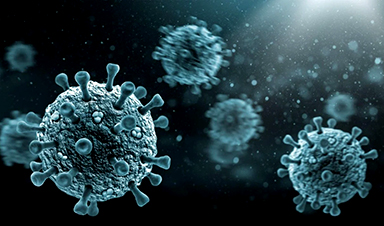Virginia Tech researchers discovered six new rodent carriers of hantavirus and identified U.S. hotspots, highlighting the virus’s adaptability and the impact of climate and ecology on its spread.
Hantavirus recently drew public attention following reports that it was the cause of death for Betsy Arakawa, wife of actor Gene Hackman. Despite the headlines, the virus remains relatively unfamiliar to many, beyond its known association with rodents.
Researchers at Virginia Tech have deepened scientific understanding of this potentially deadly virus by studying its rodent hosts across North America. Using data from the National Science Foundation, the team identified three major hotspots of hantavirus activity in wildlife: Virginia, Colorado, and Texas. They also documented 15 rodent species carrying the virus, six of which had not previously been recognized as hosts.
The findings were published in the journal Ecosphere.
A Virus With Pandemic Potential
“This project is timely because hantavirus is considered an emerging disease of pandemic potential with symptoms that resemble severe COVID-19 infections,” said Paanwaris Paansri, a Ph.D. student in the Department of Fish and Wildlife Conservation and co-author of the study.
Hantaviruses are a family of viruses that have been identified in regions all over the globe and can reach mortality rates similar to other diseases of high concern, such as nipah and Ebola. In Asia, hemorrhagic fever with renal syndrome is caused by the Hantaan virus, in Europe that syndrome is caused by the Dobrava-Belgrade virus, and in North and South America, hantavirus pulmonary syndrome is caused by Sin Nombre virus and Andes virus — all hantaviruses. Sin Nombre virus was first discovered in New Mexico in 1993.

Little is known about the ecology of hantaviruses in wildlife except that the pathogen is spread to humans by inhalation of aerosolized excreta, urine, or saliva from asymptomatic rodent hosts, and it can be fatal in humans.
The Virginia Tech team used data from the National Science Foundation’s National Ecological Observatory Network program to gain a better understanding of hantavirus circulation in its sylvatic cycle — the pathogen’s life cycle in wildlife — by examining the environmental influences and geographical distribution of the rodent hosts. The program collected and tested 14,004 blood samples from 49 species at 45 field sites across the United States from 2014-19.
New Hosts, New Insights
“In North America, Peromyscus maniculatus, the deer mouse, is the most common carrier but our study also revealed that other rodent species have a higher prevalence of hantavirus, which changes the current paradigm in hantavirus circulation in wildlife,” said Paansri, whose mentor Associate Professor Luis E. Escobar, led the study and is an affiliate with the Fralin Life Sciences Institute. “This new information is expected to help us understand where and when hantavirus is most likely to occur, which is crucial for predicting outbreaks and informing public health officials.”
The discovery of six new rodent species of hantavirus hosts is significant. Some of these newly discovered hosts inhabit regions where traditional hosts, such as the deer mouse or the white-footed mouse (Peromyscus leucopus), are absent, meaning they could be potential reservoirs of the virus in new or overlooked areas.
“This expands our understanding of the basic biology of the virus and shows that the virus is more adaptable than previously believed,” Paansri said. “This has direct implications for surveillance strategies and risk assessments and can help explain some cases of hantavirus in humans where the main reservoir is absent or rare.”
In addition to expanding the known host species, the researchers were able to gain a better understanding of seasonal trends and effects of seasonal weather shifts. For example, warmer winters and increased precipitation can increase rodent populations and drier conditions can facilitate the generation of contaminated dust containing particulates from rodent excrement and saliva, increasing the risk of transmission to humans.
The Role of Climate Change
“Climate change can cause population increases or distributional shifts of rodents, altering the epidemiology of hantavirus,” Paansri said. “These fluctuations can lead to more frequent rodent-human interactions and increase the chance of spillover. We found some evidence that rodent demography and hantavirus prevalence can be predicted months in advance.”
The actual number of human cases of hantavirus infections is largely unknown, according to Paansri, because many infections remain silent, meaning the infected individual may not develop any symptoms or the symptoms could mirror other diseases, such as the common cold or influenza.
The researchers plan to further explore the extent to which climatic variations influence hantavirus transmission in wildlife and in humans.
“We believe that many lessons learned from this study can be generalized to other wildlife diseases, considering that their distribution is global,” Paansri said.
Reference: “Hantavirus in rodents in the United States: Temporal and spatial trends and report of new hosts” by Francisca Astorga, Abdelghafar Alkishe, Paanwaris Paansri, Gabriel Mantilla and Luis E. Escobar, 16 March 2025, Ecosphere.
DOI: 10.1002/ecs2.70209
News
Global Nanomaterial Regulation: A Country-by-Country Comparison
Nanomaterials are materials with at least one dimension smaller than 100 nanometres (about 100,000 times thinner than a human hair). Because of their tiny size, they have unique properties that can be useful in [...]
Pandemic Potential: Scientists Discover 3 Hotspots of Deadly Emerging Disease in the US
Virginia Tech researchers discovered six new rodent carriers of hantavirus and identified U.S. hotspots, highlighting the virus’s adaptability and the impact of climate and ecology on its spread. Hantavirus recently drew public attention following reports [...]
Studies detail high rates of long COVID among healthcare, dental workers
Researchers have estimated approximately 8% of Americas have ever experienced long COVID, or lasting symptoms, following an acute COVID-19 infection. Now two recent international studies suggest that the percentage is much higher among healthcare workers [...]
Melting Arctic Ice May Unleash Ancient Deadly Diseases, Scientists Warn
Melting Arctic ice increases human and animal interactions, raising the risk of infectious disease spread. Researchers urge early intervention and surveillance. Climate change is opening new pathways for the spread of infectious diseases such [...]
Scientists May Have Found a Secret Weapon To Stop Pancreatic Cancer Before It Starts
Researchers at Cold Spring Harbor Laboratory have found that blocking the FGFR2 and EGFR genes can stop early-stage pancreatic cancer from progressing, offering a promising path toward prevention. Pancreatic cancer is expected to become [...]
Breakthrough Drug Restores Vision: Researchers Successfully Reverse Retinal Damage
Blocking the PROX1 protein allowed KAIST researchers to regenerate damaged retinas and restore vision in mice. Vision is one of the most important human senses, yet more than 300 million people around the world are at [...]
Differentiating cancerous and healthy cells through motion analysis
Researchers from Tokyo Metropolitan University have found that the motion of unlabeled cells can be used to tell whether they are cancerous or healthy. They observed malignant fibrosarcoma [...]
This Tiny Cellular Gate Could Be the Key to Curing Cancer – And Regrowing Hair
After more than five decades of mystery, scientists have finally unveiled the detailed structure and function of a long-theorized molecular machine in our mitochondria — the mitochondrial pyruvate carrier. This microscopic gatekeeper controls how [...]
Unlocking Vision’s Secrets: Researchers Reveal 3D Structure of Key Eye Protein
Researchers have uncovered the 3D structure of RBP3, a key protein in vision, revealing how it transports retinoids and fatty acids and how its dysfunction may lead to retinal diseases. Proteins play a critical [...]
5 Key Facts About Nanoplastics and How They Affect the Human Body
Nanoplastics are typically defined as plastic particles smaller than 1000 nanometers. These particles are increasingly being detected in human tissues: they can bypass biological barriers, accumulate in organs, and may influence health in ways [...]
Measles Is Back: Doctors Warn of Dangerous Surge Across the U.S.
Parents are encouraged to contact their pediatrician if their child has been exposed to measles or is showing symptoms. Pediatric infectious disease experts are emphasizing the critical importance of measles vaccination, as the highly [...]
AI at the Speed of Light: How Silicon Photonics Are Reinventing Hardware
A cutting-edge AI acceleration platform powered by light rather than electricity could revolutionize how AI is trained and deployed. Using photonic integrated circuits made from advanced III-V semiconductors, researchers have developed a system that vastly [...]
A Grain of Brain, 523 Million Synapses, Most Complicated Neuroscience Experiment Ever Attempted
A team of over 150 scientists has achieved what once seemed impossible: a complete wiring and activity map of a tiny section of a mammalian brain. This feat, part of the MICrONS Project, rivals [...]
The Secret “Radar” Bacteria Use To Outsmart Their Enemies
A chemical radar allows bacteria to sense and eliminate predators. Investigating how microorganisms communicate deepens our understanding of the complex ecological interactions that shape our environment is an area of key focus for the [...]
Psychologists explore ethical issues associated with human-AI relationships
It's becoming increasingly commonplace for people to develop intimate, long-term relationships with artificial intelligence (AI) technologies. At their extreme, people have "married" their AI companions in non-legally binding ceremonies, and at least two people [...]
When You Lose Weight, Where Does It Actually Go?
Most health professionals lack a clear understanding of how body fat is lost, often subscribing to misconceptions like fat converting to energy or muscle. The truth is, fat is actually broken down into carbon [...]




















